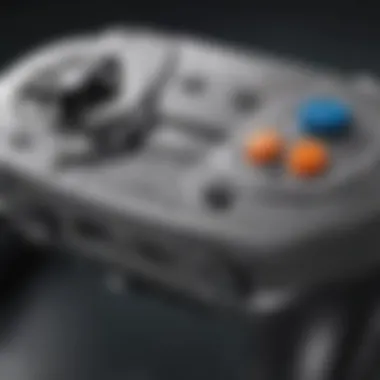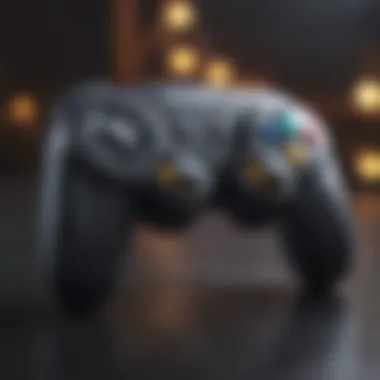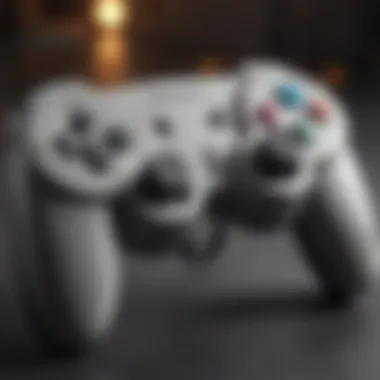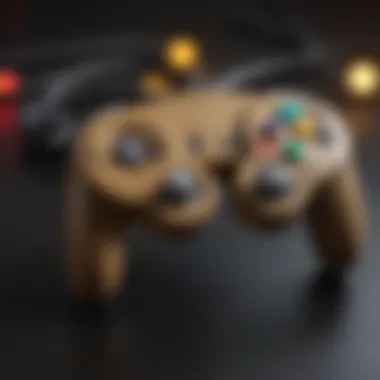The Official GameCube Controller: An In-Depth Resource


Intro
The GameCube controller stands as one of the most recognizable and beloved gaming peripherals in history. Launched alongside the Nintendo GameCube in 2001, this controller has captivated a dedicated audience for decades. Its ergonomic design, unique button layout, and durable build contribute to a user experience that has left an indelible mark on gamers.
This article aims to provide an extensive look at the GameCube controller, exploring its development, design features, and enduring appeal. As we delve deeper, we will uncover its significant impact on gaming culture, the technical specifications that set it apart, and its compatibility with modern systems. Whether you are a longtime fan or a newcomer to the gaming scene, understanding the nuances of this controller is essential in appreciating its legacy.
"The GameCube controller is not just a device for playing games; it is an experience that has shaped the way we interact with digital worlds."
From its historical context to its modern applications, we will detail every aspect that contributes to the GameCube controller's ongoing relevance today.
Preface to the GameCube Controller
The GameCube controller is a significant piece of gaming hardware as it displays the evolution of game control standards. The importance of this controller is not only in its design but also in how it shaped gaming experiences for a generation of players. The GameCube era marked a time when Nintendo sought to innovate in several aspects of gameplay. The GameCube controller is an embodiment of this drive.
Historical Context
Released in 2001 alongside the GameCube console, the GameCube controller was part of Nintendo's strategy to redefine gaming. During the early 2000s, the gaming industry was becoming more competitive with the presence of strong contenders such as Microsoft and Sony. Nintendo needed a controller that catered to both casual and hardcore gamers. This fact resulted in features that allowed flexibility in play styles. The controller incorporated a unique layout, which included a central analog stick and a C-stick for camera control.
This controller quickly became popular due to its ergonomic design and intuitive button placement, catering to various player types.
Design Philosophy
The design of the GameCube controller reflects a careful consideration of user experience. Nintendo's approach combined functionality with comfort, ensuring that players could engage in long gaming sessions without fatigue. The controller features a symmetrical design that fits well in most hand sizes. Its bulbous buttons and textured grips enhance tactile feedback, making it easier for players to discern button locations without looking.
Several features direct this design philosophy:
- Button Layout: The distinctive layout includes large face buttons, a unique A button prominently at the center, along with the other buttons surrounding it.
- Analog Sticks: The presence of two analog sticks ensures that players have precise control during gameplay.
- Triggers: The shoulder buttons are designed for ease of use, allowing for quick and reflexive actions.
- C-Stick: This smaller stick assists in camera control, especially in action-adventure and shooting genres.
The GameCube controller signifies a balance between creativity and traditional design, crafting a device that appeals broadly to the gaming community.
As a whole, the GameCube controller captured a period in gaming history where user experience began to be prioritized more than before. Its influence continues to be seen in later controller designs, underscoring its long-lasting significance in the gaming landscape.
Technical Specifications
The technical specifications of the GameCube controller are essential for understanding its functionality and user experience. These specifications encompass various elements that contribute to how effectively the controller operates with the GameCube console and other compatible platforms. A deep dive into the physical dimensions, button layout, analog stick functionality, and connectivity options reveals why these features matter for both casual and competitive gamers.
Physical Dimensions
The dimensions of the GameCube controller are thoughtfully designed to fit comfortably in the hands of diverse players. Measuring approximately 5.5 inches in width, 4.5 inches in depth, and 3.75 inches in height, it strikes a balance between compactness and functionality. The light weight of around 7.8 ounces allows for extended gaming sessions without discomfort. Understanding these physical attributes enables players to appreciate how they affect grip and maneuverability during various gaming scenarios.
Button Layout
The button layout is a fundamental aspect of the GameCube controller, influencing gameplay accessibility and responsiveness. The controller features a total of seven buttons, including the A, B, X, and Y buttons, along with L and R triggers and a Start button. The A button is particularly prominent, designed larger than others to facilitate quick access during intense gameplay. The arrangement of buttons is strategic, allowing gamers to execute complex maneuvers intuitively. The distinct design caters to a range of game genres, whether it be action, adventure, or sports.
Analog Stick Functionality
Analog sticks are critical for precise control in gaming. The GameCube controller has one central analog stick on the left and a smaller stick on the right. The primary stick has a range of motion that allows for smooth character movement and camera control. It incorporates a tactile surface that enhances grip, ensuring that movements remain accurate under pressure. This design choice enhances user engagement, making the gaming experience more immersive. The range of movement is expansive, allowing for nuanced control that is essential in fast-paced scenarios.


Connectivity Options
The GameCube controller utilizes a unique connectivity system that supports both wired and wireless connections. The wired controller connects through a proprietary port on the GameCube console, ensuring a stable connection without input lag. For those using the controller with the Wii, a compatible adapter allows for retroactive functionality. The WaveBird wireless controller variant introduces Bluetooth-like connectivity for freer movement. This flexibility in connectivity enhances its utility across platforms, appealing to both retro gamers and those interested in modern gaming setups.
In summary, understanding the technical specifications of the GameCube controller sheds light on its ergonomic design and functionality, revealing its enduring appeal among gamers of all preferences.
Compatibility with Platforms
The compatibility of the GameCube controller across various platforms underscores its significant role in gaming history. This aspect highlights not only the controller’s versatility but also its enduring relevance among gamers.
GameCube Console
The GameCube controller was designed specifically for the GameCube console itself. With its unique button layout and ergonomics, it offered a tailored gaming experience. The controller’s analog sticks and buttons were optimized for the games developed for the console. Titles such as Super Smash Bros. Melee and The Legend of Zelda: The Wind Waker utilized the controller’s features to enhance gameplay. This native connection ensured that users enjoyed a seamless interaction with their games, making it essential for the GameCube experience. The physical design and responsiveness of the GameCube controller contributed fundamentally to how games were perceived and played on the platform.
Wii Compatibility
When the Wii was released, it included backward compatibility with GameCube titles. This was a significant advancement as it allowed gamers to use their existing GameCube controllers to play classic games on the newer system. Players could continue enjoying titles without having to purchase new controllers. This compatibility bridged two gaming generations, maintaining a sense of continuity for Nintendo fans. Additionally, the ability to use the GameCube controller for select Wii games further solidified its position within the Nintendo ecosystem. Notably, games like Super Smash Bros. Brawl supported the GameCube controller, attracting both new players and veterans who preferred the traditional layout.
PC and Emulator Support
The GameCube controller has found a surprising degree of compatibility with PCs and emulators. Various tools and adapters have been developed to allow the GameCube controller to interface with personal computers. This capacity is particularly relevant for gamers who wish to experience their favorite GameCube titles via emulation software. Programs such as Dolphin Emulator provide a platform where players can utilize the GameCube controller, creating a bridge between nostalgia and modern gaming. Gamers interested in this often seek out specific adapters, such as those from Mayflash, which can facilitate the connection process.
"The ability to use the GameCube controller on PC not only extends its lifecycle but also leverages the passion of the gaming community to keep classic games alive."
The Role in Gaming Culture
The GameCube controller is more than just a device; it plays a vital role in gaming culture. It is a symbol of a unique time in gaming history and has left a lasting impact on game design and player interaction. As video games evolve, the GameCube controller remains a noteworthy example of how hardware can shape gaming experiences and community engagement.
Iconic Games Featuring the Controller
Several games on the GameCube leveraged the unique features of the controller to create memorable experiences. Titles such as Super Smash Bros. Melee, The Legend of Zelda: The Wind Waker, and Metroid Prime are notable examples where the design and functionality of the controller enhanced gameplay.
- Super Smash Bros. Melee: This game is recognized for its fast-paced action and competitive nature. The GameCube controller's responsive buttons and analog sticks provided the precision required for executing complex combos and maneuvers.
- The Legend of Zelda: The Wind Waker: The controller's layout allowed players to navigate beautifully crafted environments smoothly. The Z-trigger enabled quick access to Zelda's various items, enhancing the adventure experience.
- Metroid Prime: The use of the dual analog sticks transformed how players engaged with the first-person perspective. This innovative control scheme set new standards for similar games in the genre.
The success of these titles contributed significantly to the controller’s reputation. It is often cited as the preferred choice among competitive players, elevating its status in gaming circles.
Community and Collector's Market
The GameCube controller has a vibrant community surrounding it, contributing further to its significance in gaming culture. Enthusiasts have created forums and platforms, such as reddit.com, where they discuss mods, techniques, and experiences. This community aspect fosters a sense of belonging among gamers.
In addition, the collector's market highlights the enduring appeal of the GameCube controller. As newer gaming systems emerge, original GameCube controllers are often sought after. Collectors value them for their unique designs and sentimental feelings tied to nostalgic gaming experiences.
- Customization: Some players modify their controllers for enhanced performance or aesthetic appeal. This trend has generated a niche of custom artwork and hardware upgrades.
- Events: Tournaments frequently feature the GameCube controller as the standard, affirming its place in competitive gaming settings.
The combination of community engagement and collector interest ensures the GameCube controller remains relevant, while also establishing a bridge between nostalgic gamers and newer audiences.


User Experience and Ergonomics
User experience and ergonomics are vital components when assessing any gaming controller. These factors influence how a player interacts with the device, impacting both comfort and performance. For the GameCube controller, this relationship is especially significant. The design offered by Nintendo embraces these principles to ensure that gamers not only enjoy extended sessions but also do so with minimal strain or fatigue. Understanding these important aspects can help both casual players and avid gamers appreciate the controller’s long-standing appeal.
Hand Comfort and Usability
The GameCube controller is designed to fit comfortably in the average hand size. Its shape is a distinctly contoured form that supports natural grip and minimizes awkward wrist angles. The positioning of the analog sticks and buttons allows for easier access, which translates to a more engaging gaming experience.
The handle grips are slightly rounded, which offers a pleasant feel over prolonged usage. This design choice reduces the chances of slipping during intense gaming moments. Additionally, the thumb placement is intuitively aligned with key controls, allowing for quick and efficient maneuvers without needing to adjust grip. A well-designed controller can reduce physical strain, which is important for gamers who may spend many hours playing.
- Considerations: It's crucial to note that individual preferences in hand size and shape might slightly alter one’s experience. However, the overall design effectively accommodates a wide variety of users, hence boosting its usability across different demographics.
Feedback from Gamers
Listening to the feedback from gamers is essential for understanding how effective a controller's ergonomics are. Many players have expressed satisfaction with the GameCube controller’s design. Reviews often highlight the balance between the weight of the controller and the button responsiveness.
Many users report that the button layout caters well to various gaming genres, from action to adventure. The analog sticks are praised for their precise control, leading to better performance in games requiring fine movements. Additionally, the feedback on the triggers and bumpers indicates that they are well-placed and easy to engage without feeling awkward.
"The GameCube controller feels like an extension of my hands. I can play for hours without a hint of discomfort." - A common sentiment among various gaming communities.
Overall, the feedback regarding comfort and usability underlines the importance of user-centric design in gaming peripherals. Many gamers appreciate how the GameCube controller enhances their gaming experience, reinforcing the relevance of ergonomics in modern controller design.
Comparative Analysis
The section on comparative analysis plays a critical role in this article. Analyzing the GameCube controller in relation to both other Nintendo controllers and those from competing brands helps to contextualize its unique features and design philosophy. Through this comparison, readers gain a deeper understanding of what sets the GameCube controller apart and its lasting influence in the gaming industry. This comparison also highlights the evolutionary trajectory of controller design and technology, providing insights into trends that shaped modern gaming peripherals. Evaluating its strengths and weaknesses relative to its contemporaries can inform future purchases and enhance the gaming experience for users.
Versus Other Nintendo Controllers
When discussing the GameCube controller, it is essential to compare it with other Nintendo controllers. The Super Nintendo Entertainment System (SNES) controller, for instance, is revered for its simplicity. It featured a basic layout with just four face buttons and a D-Pad. Conversely, the GameCube controller introduced a more complex button layout, including six face buttons, which provided enhanced functionality. This development indicated a shift towards more engaging gameplay, especially for action-adventure and multi-player games.
Another notable controller to consider is the Wii U Pro Controller. This model adopted a more conventional layout reminiscent of modern dual-analog controllers, which offers a different feel for gameplay compared to the GameCube's unique ergonomic design. The comfort provided by the GameCube controller is still appreciated in competitive gaming environments, where layout familiarity can greatly influence performance.
In terms of build quality, the GameCube controller stands out due to its more robust casing, designed to withstand the rigors of intense gaming sessions. While the Wii controller offered an innovative motion-sensing experience, it could not match the tactile feedback and responsiveness found in the GameCube controller that loyal gamers prefer.
Versus Controllers from Competing Brands
Examining the GameCube controller in relation to controllers from competing brands also reveals its superior aspects. For example, the Sony PlayStation DualShock series features dual analog sticks and vibration feedback. While this offered a more immersive experience in specific game genres, the GameCube's asymmetrical layout catered well to titles like "Super Smash Bros. Melee" which demand quick thumb movements. Gamers often find that the GameCube controller allows for faster input due to its comfortable grip and accessibility of buttons.
The Xbox controller is another significant point of comparison. Known for its heft and bulk, the Xbox controller may feel comfortable for some but can be cumbersome for long sessions. In contrast, the GameCube controller was specifically designed with the player's hand in mind, allowing for less fatigue and better performance.
In summary, the GameCube controller not only excels in its unique ergonomic design and button layout but also in adaptability across gaming genres. By comparing it effectively with its peers, both within the Nintendo family and beyond, we can appreciate its enduring legacy in an increasingly crowded market.
Modifications and Customization
The Modifications and Customization of the GameCube controller reflect the dynamic engagement of a dedicated gaming community. It signifies not merely a desire for personalization but also enhances the functionality of the device. Customizations can range from improving grip to modifying internal components for better performance. This aspect is pivotal for gamers who seek to create a unique identity in their gaming setup and to optimize use according to their personal preferences.


Hardware Modifications
Hardware modifications of the GameCube controller often involve changing or upgrading internal components. This could include upgrading the analog sticks for enhanced precision or replacing standard buttons with responsive ones. Some enthusiasts also integrate additional features like remappable buttons or extra programmable features for competitive gaming.
These changes can lead to improved accuracy during gameplay, a key factor for genres that require swift reflexes, such as first-person shooters or fighting games. Furthermore, many modifications allow for better durability, prolonging the controller’s lifespan beyond that of a standard unit. However, there are considerations. Many gamers must weigh the benefits of modification against the risk of voiding warranties or damaging the equipment.
Custom Designs and Artwork
Custom designs and artwork provide a visual showcase of creativity and personal expression. Gamers often opt for custom shells that showcase their favorite characters or motifs from various franchises. This can include hand-painted designs or decals that cover the controller.
Not only do these personalized designs serve an aesthetic purpose, but they can also create strong connections to the gaming community. Many collectors appreciate the uniqueness of a custom controller, often increasing its value in niche markets. However, customizing designs requires careful consideration of materials to ensure that their functionality remains unaffected. Through a vibrant mix of artistry and functionality, custom designs offer yet another avenue for gamers to showcase their passion for gaming beyond standard aesthetics.
"Each modification or design choice tells a story about the user’s connection to gaming." - Unattributed
By exploring modifications and customization, one can see the rich culture surrounding the GameCube controller. It is not merely a tool for playing games; it is a canvas for personal expression and technical enhancement.
The Legacy of the GameCube Controller
The legacy of the GameCube controller extends far beyond its initial release. This piece of hardware has made its mark, influencing not just gaming design but also the overall landscape of controller ergonomics and functionality across generations. Its unique approach to design, combined with its cultural impact, makes for a fascinating study.
Influence on Future Nintendo Controllers
The GameCube controller has played a pivotal role in shaping subsequent Nintendo controllers. Its successor, the Wii U Pro Controller, retained several design elements that hearkened back to the GameCube. The placement of analog sticks, the button configuration, and overall handling ergonomics were directly inspired by this earlier design. In addition, newer controllers like the Nintendo Switch Pro Controller carry forward the legacy of the GameCube's accessible and comfortable grip.
The GameCube controller’s focus on player comfort and ease of use set a standard for spacing and arrangement of buttons. Many developers consider any advancement in controller design incomplete without acknowledging the influences from the GameCube model. Features such as the dual analogue sticks became a standard in many gaming controllers, taking cues from GameCube’s design philosophy.
Nostalgia and Continued Relevance
Nostalgia plays a huge part in the continuing relevance of the GameCube controller. For many gamers, this controller represents fond memories of their childhood and adolescent gaming experiences. The resonance of iconic games like Super Smash Bros. Melee is a significant factor. Even decades later, the controller remains a favorite for competitive gaming, especially within the Smash community.
Events continue to emerge with a focus on retro games, where players still prefer to use the original GameCube controller for the authentic experience. Collectors also recognize the value of this controller, often seeking out limited editions or custom designs, further adding to its legacy. The emotional connection that gamers have with the GameCube controller is not just about nostalgia, but about recognition of quality design that endures.
"The GameCube controller's influence can still be felt today in the designs of many modern gaming peripherals."
In summary, the GameCube controller's legacy is multifaceted. It has influenced future designs, shaped gaming habits, and continues to be a source of nostalgia for players. As gaming technology evolves, the essence of what made the GameCube controller special remains embedded in the DNA of modern controllers.
Closure
The concluding section of this article on the official GameCube controller is essential for comprehensively understanding the legacy and ongoing relevance of this controller. It encapsulates critical aspects discussed throughout the text. By highlighting the controller's unique features and its compatibility with various platforms, we reiterate its significance not only in the past but also in the present gaming landscape.
Summarizing Key Points
To summarize, the GameCube controller stands out for several reasons:
- Innovative Design: The controller introduced analog triggers, a unique button layout, and an ergonomic form that many players find comfortable to use.
- Cultural Impact: Specific games like "Super Smash Bros. Melee" became iconic, helping to solidify the controller's place in gaming history.
- Versatility: It remains compatible with modern consoles and PC through adapters, showcasing its adaptability.
- Customization: Enthusiasts engage in unique hardware modifications and visual customizations, reflecting personal style and enhancing gameplay experience.
These points encapsulate why the GameCube controller has retained its status as a beloved piece of gaming equipment.
Future Prospects
Looking ahead, the future prospects for the GameCube controller and its design legacy remain promising. With retro gaming experiencing a resurgence, interest in original hardware and controllers is likely to grow.
- Emulator Support: As emulators continue to improve, gamers will likely seek authentic experiences, making the GameCube controller a prime choice.
- Collector's Market: The collector's market for gaming peripherals is expanding, and the GameCube controller's nostalgic value ensures continued interest.
- Technological Advances: Future adaptations or modern versions of the GameCube controller could emerge, keeping its essence alive while incorporating enhanced features.



